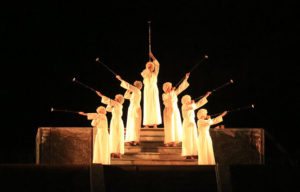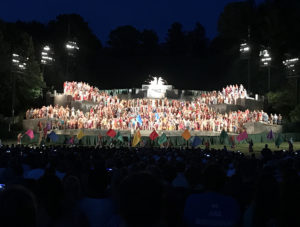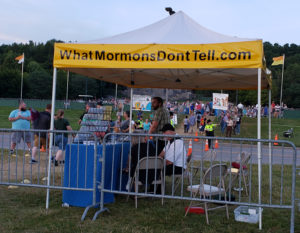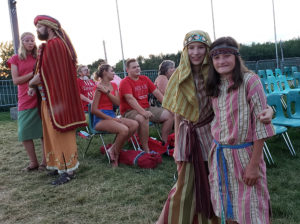Enjoying an Evening with Jesus
 Heralds perform at the Hill Cumorah Pageant (photo by Tim Lenz via Flickr)
Heralds perform at the Hill Cumorah Pageant (photo by Tim Lenz via Flickr) Why would a humanist family travel to see the Hill Cumorah Pageant—a live, outdoor performance about the Book of Mormon? Pure curiosity.
Each July the Pageant brings about 100,000 people to Palmyra, New York, a small village of about 3,500 residents just outside of Rochester. My mother grew up less than five minutes from Hill Cumorah, a geographic landmark adorned with a statue of the angel Moroni to mark where he led Joseph Smith to find the Book of Mormon (inscribed on golden plates). Her brothers used to sit excitedly by the side of the road on performance nights to watch the flood of cars and record the states they saw. My mom’s family never attended because their Catholic priest said the pageant was “a wolf in sheep’s clothing” trying to convert them. That’s essentially true, though the LDS church has stepped back from that focus by not requiring missionary attendance anymore. When my parents went in the early 2000s, a missionary reassured my father that they accept his people—Jews—and actually have a lot in common.

The stage at Hill Cumorah (photo courtesy of the Newman family)
Part of my curiosity also had to do with my interest in the performing arts. Everyone in my family has been part of a play, chorus, or band, so we knew it would be impressive to view a production of this magnitude. The Hill Cumorah Pageant website warned that we would experience a prophet burning, hear explosions, see a 5,000-kelvin carbon arc light “star,” and witness Jesus descending from the sky. There are seven stages rigged around Hill Cumorah with some scenes taking place on the hill above them. Scenes are lit with over 450 lighting instruments and amplified with seventy-five speakers. A team of five directors, two choreographers, and a battle master lead an 800-member volunteer cast wearing 1,400 costumes, 300 wigs, and 100 beards all handmade by volunteers. The music, dialogue, and sound effects are pre-recorded so the actors are mostly dancing, fighting, and emoting with their arms. It’s also worth noting that performances are free and concession stands are run by local organizations who keep all their proceeds.
The pageant has existed for over eighty years but will have its final performances in 2020. Early on, missionaries simply met for annual gatherings at the Joseph Smith Farm. This community gradually expanded their festivities—and opened up more activities to the public—as the LDS Church acquired more land. They added a musical program in 1935, as part of the dedication services for the Angel Moroni Monument, and began using a script of scenes from the Book of Mormon in 1937. The current script was first performed in 1988 and was written by Orson Scott Card—Hugo and Nebula award-winning novelist of Ender’s Game and great-great-grandson of Brigham Young. Award-winning composer Crawford Gates wrote the musical score.

The protest area (photo courtesy of the Newman family)
My family was impressed with the pageant’s efficient parking plan that directed visitors based on whether the car was headed north or south afterwards. As we walked in, I noted cars from Utah, Missouri, Virginia, Maryland, Oregon, Ohio, Florida, and Ontario, as well as untold numbers of buses. In between parking and the performance area were about thirty protestors—both adults and children—with handouts, signs, and a tent directing onlookers to whatmormonsdonttell.com. This group was part of the Christian Research & Counsel whose mission it is to educate people about how Mormons aren’t the right kind of Christians.
Incidentally, although the Mormon Church has taken over the area by the Hill Cumorah (including Joseph Smith Farm, the Sacred Grove, a church and temple, and the visitor’s center), Mormons don’t make up a significant portion of the population in Palmyra, compared to the Catholics and Protestants.

Young performers at the Hill Cumorah Pageant (photo courtesy of the Newman family)
Entering the performance area, we were welcomed by the multi-generational cast—even saw a very young child in a tunic toddling around—reminiscent of a Renaissance fair. Instead of memorizing a script, the actors were trained to interact with the audience. First they smile, wave, and thank you for coming. If they catch your eye or you respond, they then ask where you came from and if you’ve seen the show before. If you seem interested in conversation, they then offered to tell you about the performance and if you stick around, I’m told they talk about their faith. I only talked with cast members about the performance but wondered how they were trained to handle confrontation from non-LDS members. Everyone I observed was enjoying friendly conversation. I learned that people apply to join the cast in January and are all cast in one day. Many families and teen groups join together. It takes seven days to prepare for the show and seven nights to perform it, and in between shows there are several service projects to support the local area.
As the sun went down, music beckoned the cast down the aisles to the stage and a woman dressed in white gave an opening prayer (notably, the most words spoken by a woman in the whole performance). The performance itself was fascinating. I loved the ship-building and shipwreck scenes, the use of light and water were fun to watch, and the cross burning was very dramatic. But, as predicted, we didn’t find the story thrilling. In summary, multiple male prophets have visions from God about the need to repent, and they try to convince others. Those who follow are rewarded and those who don’t are punished. Some who are punished learn and change but others don’t. Then Jesus comes to America and performs miracles but still there’s division. The script skipped past stories in the Book of Mormon to the burying and finding of the golden plates and closed with a reminder to the audience that love for Jesus is all that matters.
The most poignant line for me was: “Divisions led to anger, anger led to hate, hate led to war.” So true, but that’s because people aren’t prioritizing empathy and collaboration. The sinners only cared about themselves and the believers only cared about Jesus. When I got frustrated with the plot, I looked around at the various families enjoying a nice country night together. I looked past the stage to the thick trees surrounding it. I looked up at the clear sky full of stars. And I thought about all the dedicated people who used their talents to make the event possible, on and off the stage. I appreciate them giving me this unique experience.
